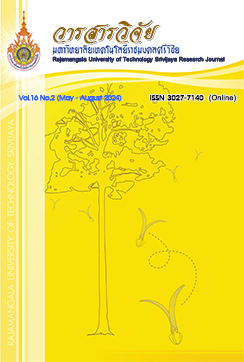The Comparison of Inulin Extraction Methods from Jerusalem Artichoke (Helianthus tuberosus)
Keywords:
inulin, extraction, Jerusalem Artichoke (Helianthus tuberosus)Abstract
The comparison of inulin extraction methods from Jerusalem artichoke was investigated. The extraction methods consisted of 1) distilled water at 80ºC, 2) 80% ethanol (v/v) at 80ºC, 3) microwave extraction (406W) for 60 minutes, and 4) ultrasonic extraction at 80ºC for 60 minutes. The study of the chemical composition of Jerusalem artichoke powder revealed the moisture content of 14.01±0.04% with crude protein, crude fat, crude fiber, ash and carbohydrates content of 2.93±0.09, 1.27±0.01, 3.98±0.04, 1.03±0.05 and 76.78±0.04, respectively. Total sugar, reducing sugar and inulin content of Jerusalem artichoke extract solution were analyzed. It was found that the extraction method using ethanol solution showed the highest of total sugar (136.867+10.22 mg/ml) and the inulin content (66.526±6.10%) compared to other methods. The microwave extraction resulted in the highest reducing sugar content (6.689±1.86 mg/ml) (p≤0.05). The total soluble solids (TSS) of inulin extracted using ethanol, distilled water and microwave extraction showed higher than ultrasonic extraction methods (p≤0.05). However, pH of the inulin extracted solution was non significantly different (p>0.05). Color analysis of L* a* and b* was also investigated. Inulin extracted solution from distilled water displayed the highest brightness (L*) (29.37±0.13) (p≤0.05). The redness value (a*) of inulin extracted solution using the four extraction methods was not significantly different (p>0.05). Inulin extracted solution using distilled water showed the highest yellowness value (b*) (4.79±0.02) (p≤0.05), followed by ethanol, microwave and ultrasonic extraction methods (4.55±0.16, 3.84±0.06 and 3.74±0.07, respectively). Therefore, the extraction method using 80% ethanol (v/v) at 80ºC provided the highest inulin content and did not eliminate physical and chemical properties of Jerusalem artichoke.
References
AOAC. 2000. Official Method of Analysis of AOAC International. 18thed. The Association of Official Analytical Chemists, Arlington, Virginia.
Afoakwah, A.N., Owusu, J., Adomako, C. and Teye, E. 2012. Microwave Assisted Extraction (MAE) of antioxidantconstituents in plant materials. Global Journal of Bio-Science and Biotechnology 1(2): 132-140.
Azwanida, N.N. 2015. A review on the extraction methods use in medicinal plants, principle, strength and limitation. Medicinal and Aromatic Plants 4(3): 1-6.
Chatchawanphan, T., Siriek, N., Mekmek, P. and Miphaendi, L. 2010. Study optimal conditions for ethanol production from cattail by fermentation method. Master Thesis of Biology, Rajamangala University of Technology Thanyaburi. (in Thai)
Changhelik, P. 2012. Kaeng Tawan, a medicinal plant to control weight. Popular Science. Available Source: https://www.dss.go.th/ images/st-article/sti-2-2558-SunChoke.pdf., April 25, 2022. (in Thai)
Johansen, H.N., Glitso, V. and Knudsen, K.E.B. 1996. Influence of extraction solvent and temperature on the quantitative determination of oligosaccharides from plant material by hight performance liquid chromatography. Journal Agriculture Food Chemistry 44: 1470-1474.
Khan, E.A., Khakwani, A.A., Munir M. and Ghazanfarullah, A. 2015. Effects of allelopathic chemicals extracted from various plant leaves on weed control and wheat crop productivity. Pakistan Journal of Botany 47(2): 735-740.
Luthria, D., Mukhopadhyay, S. and Kwansa, A. 2006. A systematic approach for extraction of phenolic compounds using parsley (Petroselinum crispum) as a model substrate. Journal of the Science of Food and Agriculture 86: 1350-1358.
Malai, D., Chaichawalit, C., Janphen, S. and Mailaead, S. 2013. Development of fresh Noodles by substitution of jerusalem artichoke powder. Agricultural Science Journal 44(2) (Suppl.): 269-272. (in Thai)
Nawakkam, N., Kaewnaree, P., Buasri, A. and Mongkolsawat, W. 2016. Production of ethanol from sugarcane by using biomass Clostridium acetobutylicum TISTR 1462. Engineering Journal 3: 109-114. (in Thai)
National Food Institute. 2007. Product standard for milk powder industry. Available Source: http://fic.nfi.or.th/law/upload/file1/TH_381.pdf, April 25, 2022. (in Thai)
Nadir, A.S., Helmy, I.M.F. and Kamil, M.M. 2011. Effect of using Jerusalem artichoke and inulin flours on producing low carbohydrate high protein pasta. Australian Journal of Basic and Applied Sciences 5(12): 2855-2864.
Phiwsaxad, J. and Sripaya, S. 2017. Kaen Sunflower is a very valuable medicinal plant. Popular Science. Available Source: https://www.dss. go.th/imagesst-article/sti-2-2558-SunChoke. pdf., April 25, 2022. (in Thai)
Phuakrai, M., Techawngkhsethiyr, S. and Jokloy, S. 2012. Changes in quality and quantity of inulin in ready-to-eat trimmed sunflower roots during storage. Agricultural Science Journal 43(3)(Suppl.): 608-611. (in Thai)
Ponchalermwong, P. and Rattanapanon, N. 2019. Reducing sugar. Popular Science. Available Source: Food Wiki | Food Network Solution, April 25, 2022. (in Thai)
Rodrigues, S. and Pinto, G.A.S. 2007. Ultrasound extraction of phenolic compounds from coconut (Cocos nucifera) shell powder. Journal of Food Engineering 80: 869-872.
Sangchoat, J., Khienpanya, N., Pracomnok, P. and Poliarern, W. 2012. Study on optimum conditions for cattail stalk acid digestion for ethanol production. Master Thesis of Biology, Rajamangala University of Technology Thanyaburi. (in Thai)
Sasithorn, N., Luepong, K. and Padung, W. 2008. Research Report on Cooling water recovery from water distillation equipment. University of Technology Phra Nakhon, Bangkok. (in Thai)
Suedee, A. 2017. Using microwave waves to extract important substances from medicinal plants. EAU Heritage Journal Social Science and Humanities 11(1): 1-14. (in Thai)
Warinhomhaun, S., Sritularak, B. and Charnvanich, D. 2018. A simple high performance liquid chromatographic method for quantitative analysis of brazilin in caesalpinia sappan L. extracts. Thai Journal of Pharmaceutical Sciences 42: 208-213.
Downloads
Published
How to Cite
Issue
Section
License
Copyright (c) 2024 Rajamangala University of Technology Srivijaya Research Journal

This work is licensed under a Creative Commons Attribution-NonCommercial-NoDerivatives 4.0 International License.
The content and information in the article published in Journal of Rajamangala University of Technology Srivijaya It is the opinion and responsibility of the author of the article. The editorial journals do not need to agree. Or share any responsibility.







